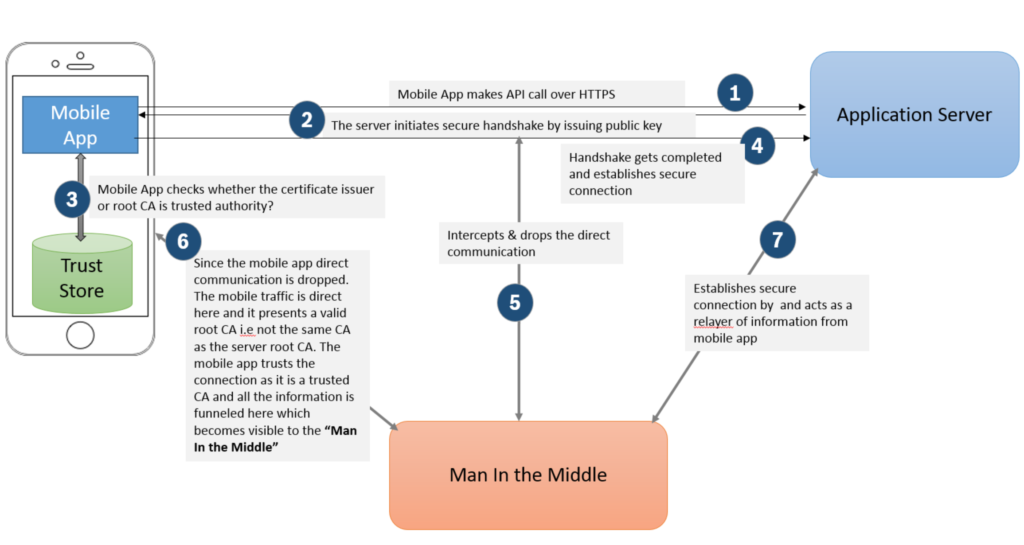Mobile applications frequently do not protect network traffic. They may use SSL/TLS during authentication but not elsewhere. This inconsistency leads to the risk of exposing data and session IDs to interception. The use of transport security does not mean the app has implemented it correctly. The diagram below illustrates how a secure connection can be compromised.

Solution
Pinning is the process of associating a host with their expected X509 certificate or public key. Once a certificate or public key is known or seen for a host, the certificate or public key is associated or ‘pinned’ to the host. If more than one certificate or public key is acceptable, then the program holds a pinset (taking from Jon Larimer and Kenny Root Google I/O talk). In this case, the advertised identity must match one of the elements in the pinset.
A host or service’s certificate or public key can be added to an application at development time, or it can be added upon first encountering the certificate or public key.
The former – adding at development time – is preferred since preloading the certificate or public key out of band usually means the attacker cannot taint the pin. If the certificate or public key is added upon first encounter, you will be using key continuity. Key continuity can fail if the attacker has a privileged position during the first encounter.
Pinning leverages knowledge of the pre-existing relationship between the user and an organization or service to help make better security related decisions. Because you already have information on the server or service, you don’t need to rely on generalized mechanisms meant to solve the key distribution problem. That is, you don’t need to turn to DNS for name/address mappings or CAs for bindings and status. One exception is revocation and it is discussed below in Pinning Gaps. It is also worth mention that Pinning is not Stapling. Stapling sends both the certificate and OCSP responder information in the same request to avoid the additional fetches the client should perform during path validations.
Certificate
The certificate is easiest to pin. You can fetch the certificate out of band for the website, have the IT folks email your company certificate to you, use openssl s_client to retrieve the certificate etc. When the certificate expires, you would update your application. Assuming your application has no bugs or security defects, the application would be updated every year or two.
At run-time, you retrieve the website or server’s certificate in the callback. Within the callback, you compare the retrieved certificate with the certificate embedded within the program. If the comparison fails, then fail the method or function.There is a downside to pinning a certificate. If the site rotates its certificate on a regular basis, then your application would need to be updated regularly. For example, Google rotates its certificates, so you will need to update your application about once a month (if it depended on Google services). Even though Google rotates its certificates, the underlying public keys (within the certificate) remain static.
Public Key
Public key pinning is more flexible but a little trickier due to the extra steps necessary to extract the public key from a certificate. As with a certificate, the program checks the extracted public key with its embedded copy of the public key. There are two downsides two public key pinning. First, its harder to work with keys (versus certificates) since you usually must extract the key from the certificate. Extraction is a minor inconvenience in Java and .Net, buts its uncomfortable in Cocoa/CocoaTouch and OpenSSL. Second, the key is static and may violate key rotation policies.
Hashing
While the three choices above used DER encoding, its also acceptable to use a hash of the information (or other transforms). Hashing also provides three additional benefits. First, hashing allows you to anonymize a certificate or public key. This might be important if you application is concerned about leaking information during decompilation and re-engineering. Second, a digested certificate fingerprint is often available as a native API for many libraries, so its convenient to use.
Finally, an organization might want to supply a reserve (or back-up) identity in case the primary identity is compromised. Hashing ensures your adversaries do not see the reserved certificate or public key in advance of its use. In fact, Google’s IETF draft websec-key-pinning uses the technique.
iOS Sample Code
- (void)connection:(NSURLConnection *)connection willSendRequestForAuthenticationChallenge:(NSURLAuthenticationChallenge *)challenge
{
SecTrustRef serverTrust = challenge.protectionSpace.serverTrust;
SecCertificateRef certificate = SecTrustGetCertificateAtIndex(serverTrust, 0);
NSData *remoteCertificateData = CFBridgingRelease(SecCertificateCopyData(certificate));
NSString *cerPath = [[NSBundle mainBundle] pathForResource:@"MyLocalCertificate" ofType:@"cer"];
NSData *localCertData = [NSData dataWithContentsOfFile:cerPath];
if ([remoteCertificateData isEqualToData:localCertData]) {
NSURLCredential *credential = [NSURLCredential credentialForTrust:serverTrust];
[[challenge sender] useCredential:credential forAuthenticationChallenge:challenge];
}
else {
[[challenge sender] cancelAuthenticationChallenge:challenge];
}
}
